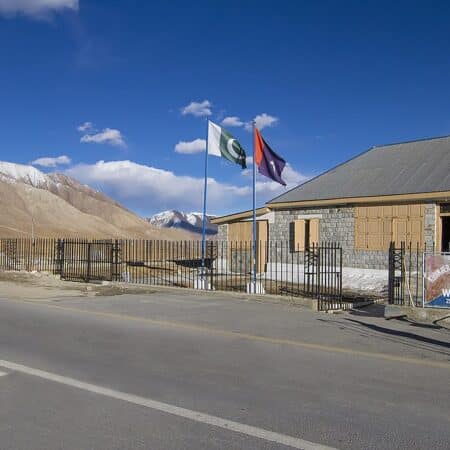
Pakistan’s NTMs: Challenges At the Border for Importers
Pakistan Institute of Development Economics (PIDE) in collaboration with the World Bank hosted a webinar on 26th October 2020 to present and discuss the International Trade Center’s “Invisible Barriers to Trade – Pakistan: Business Perspectives”. The report highlights several challenges faced by Pakistani businesses as they seek to expand their footprint in international markets. Pakistani exporters face significant challenges as compliance to non-tariff measures (NTMs) imposed by trading partners on their imports is overly complex or trade-restrictive as businesses may not only face prohibitions but report strict requirements on product quality in destination markets. Furthermore, businesses report procedural obstacles related to trade that can arise in Pakistan, during transit or in destination countries. Lack of appropriate information and difficulties in retrieving information made available to businesses impedes border facilitation.
Although, the challenges faced by exporters are more extensively studied, the report highlights that importers too face significant challenges as they experience regulatory or procedural obstacles. The report identifies 46 percent of the importers surveyed facing difficulties with NTMs. The inspection process for the importers tends to be long as they tend to struggle with documentation.
The purpose here is to analyze the extent of NTMs imposed by Pakistan on its imports by comparing its frequency and coverage ratio across different countries. The countries or regions included in the analysis are either major export destination markets for Pakistani exporters, such as the US, the EU and China (CHN) or important regional trade powerhouses such as India (IND) and Vietnam (VNM). NTMs are classified into different categories based on whether they impact importers either ‘at the border’ through various customs regulations or ‘beyond the border’ through product and process regulations. These classifications differ from the one provided by data collecting agencies and can have differing impact on the prices of goods available in the domestic market.
Customs regulations include quantitative restrictions as well as licensing, inspection and certification processes at the border. They drive a wedge between the world price and the domestic price of a good that is imported. Product and process regulations increase the fixed cost of production as they may influence the characteristics of the products imported in the case of the former or regulate the methods used in producing the product imported in the case of the latter. These measures increase the supply price of goods available in the market, likely inhibiting the supply of poor quality goods. On the other hand, such measures can help reduce market failures by addressing information asymmetries and negative externalities. Consumer regulations include price control measures, creating a wedge between producer and consumer prices. It is pertinent to mention that WTO bans the use of quantitative restrictions on trade. Further, the national treatment principle of the WTO ensures that imported goods do not receive less favorable treatment than that provided to similar products of domestic origin. However, WTO does allow certain exceptions to both restrictions.
The data on NTMs imposed by Pakistan is extracted from UNCTAD’s NTM Hub. NTMs are classified for products at the HS six digit level. The data on imports at the HS six digit-level is extracted from ITC’s Trademap.org. The frequency index is calculated as the proportion of products facing NTMs while the coverage ratio is calculated as the proportion of imports facing NTMs. The theory-based classification that divided NTMs into customs, product, process and consumer regulations is borrowed from Ederington and Ruta (2016).
Figure 1 highlights the frequency index and the coverage ratio of NTMs imposed by selected countries or regions. Pakistan has the lowest frequency index and coverage ratio of NTMs compared to the other countries. Pakistan is less likely to adopt NTMs than tariffs as trade policy instruments. According to World Bank’s recent study titled “Modernizing Trade in Pakistan: A Policy Roadmap”, Pakistan is ranked as the world’s seventh most protected economy with relatively high tariff rates on imports. Although, Pakistan adopts the least number of NTMs across each of the four classifications as observed in Figure 2, customs regulations is likely to be the most prominent amongst the other classifications[1].
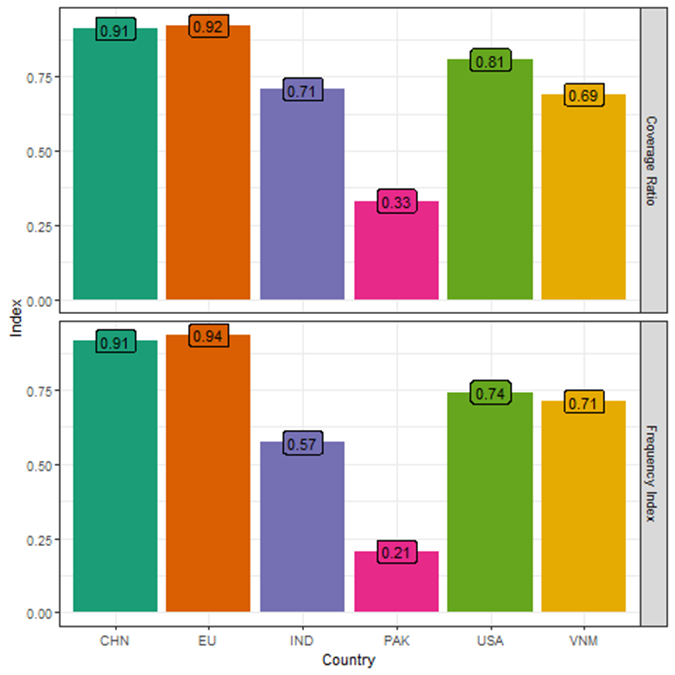
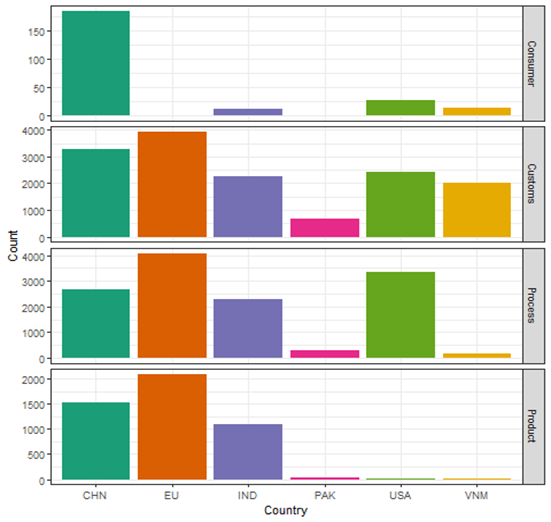
Customs regulations impact a significant share of imports reporting NTMs based on the four different classifications in Pakistan as well as in other countries as observed in Figure 3, product and process regulations have a limited role on imports into Pakistan[2]. However, in countries where trade is well-facilitated at the border, a higher share of imports covered by customs regulations does not necessarily mean that importers face greater challenges. Considering the extent of customs regulations using different instruments including non-automatic licensing, sanitary and phytosanitary measures (SPS) and technical barriers to trade (TBT), the most prominent form of NTM adopted by Pakistan in terms of the imports it covers is non-automatic licensing such as quotas and conditional prohibition as observed in Figure 4. The relatively low levels of imports into Pakistan in products reporting other measures suggests that such NTMs are likely prohibitive. On the other hand, TBT certifications impact a larger percentage of imports in all the other listed countries.
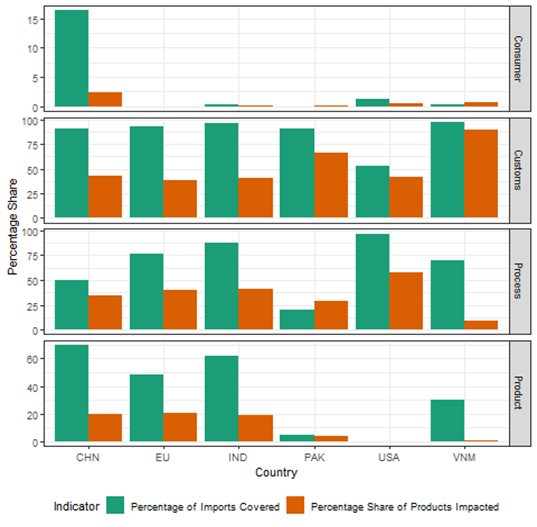
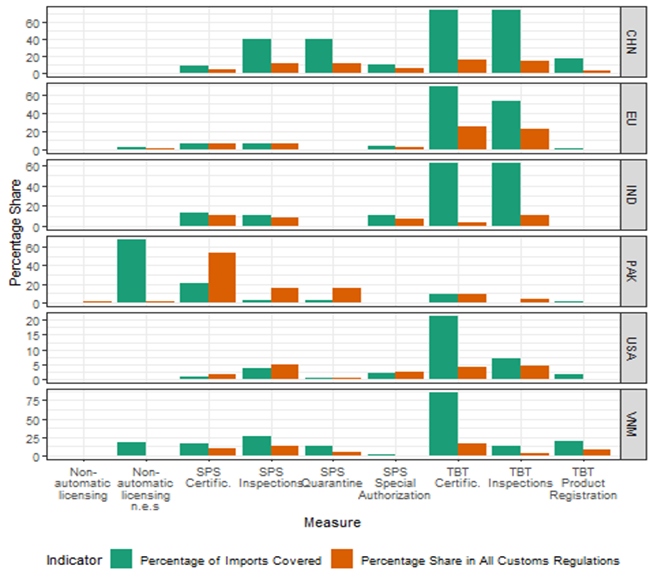
In essence, importers are not only burdened by NTMs at the border as reported by ITC but face a range of NTMs that are different than those adopted by important trading counterparts and other regional countries. With a stronger focus on ‘at-the-border’ measures compared to other measures, the limited nature of ‘beyond-the-border’ measures adopted by Pakistani policymakers may fail to tackle market imperfections. This likely has an adverse impact on the participation in global and regional value chains as well, particularly if such regulations limit trade instead of reducing market imperfections. Therefore, the composition of the NTMs adopted by Pakistan and its divergence from other countries is an important topic for researchers interested in trade related issues in Pakistan.
References:
Ederington, J., & Ruta, M. (2016). Non-tariff measures and the world trading system. Washington (DC): World Bank Group. Policy Research Working Paper No. WPS, 7661.
International Trade Centre. (2020). Pakistan: Invisible barriers to trade. Business perspectives. ITC, Geneva.
Rocha Gaffurri, N. P., Laakso, A., Mckenna, J. M., & Varela, G. J. (2019). Modernizing Trade in Pakistan: A Policy Roadmap (No. AUS0001114, pp. 1-164). The World Bank.
[1] The theory-based classifications do not necessarily cover all the different types of NTMs imposed by the importing country.
[2] As one product may report multiple NTMs across different classifications, the total percentage of imports covered by the theory-based classifications can exceed 100.



